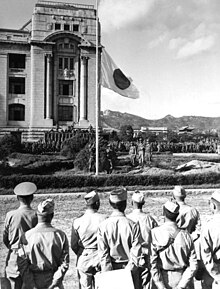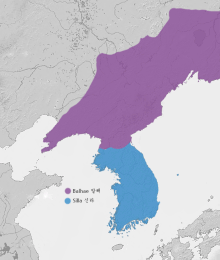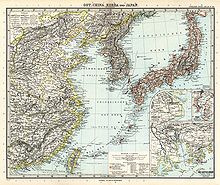History of korea
| History of korea |
|---|
| Prehistoric Korea |
|
| Antiquity |
| Proto-three realms |
|
| Time of the Three Kingdoms |
| Northern and Southern states |
|
| Later three realms |
|
| States of imperial unity |
|
| Colonial times |
|
| Division of Korea |
|
The history of Korea was closely linked to the history of China until the 19th century . An Empire of Korea existed from 1897 to 1910 . After that, Korea became a Japanese colony .
After the Second World War it came under the competing occupying powers Soviet Union and United States to the division of Korea : First, the Republic of Korea was on August 15, established in 1948 ( South Korea ) and in response, on 9 September 1948, the Democratic People's Republic of Korea ( North Korea ). The Korean War (1950–1953) deepened the division of the country.
Prehistoric Korea
Old Stone Age
The Korean peninsula was probably settled for the first time during the Old Paleolithic . This is indicated by about 30 sites from the Paleolithic , which extend over the entire Korean peninsula and parts of northeast China. A large part of the finds consists of stone, horn and bone tools, with the cut stone tools clearly dominating.
Other finds include stone animal sculptures or animal figures engraved in stone, which indicate artistic or magical-religious activities. Furthermore, bones of Homo erectus were found, including two completely preserved children's skeletons. With the help of radiocarbon dating, some of the finds could be estimated to be between 400,000 and 500,000 years old.
The early inhabitants of the Korean peninsula lived in caves or huts that they built themselves and were often located in sunny spots near water sources. They used fire for heating and cooking and made a living from hunting, fishing and collecting fruit, berries and edible roots. Today's Koreans are not, however, ethnic descendants of these early residents.
Middle and Neolithic
Archaeological finds suggest that the peninsula was settled around 18,000 to 12,000 years ago. According to current knowledge, the indigenous population of the peninsula is made up of nomadic tribes from the Siberian-Northeast Asian region in the north of the Korean peninsula and proto-Austronesian peoples in the south of the Korean peninsula. So-called comb ceramics with a herringbone pattern have been found in all regions of the country. The culture of the Jeulmun period from 6000 to 1500 BC BC shows great similarity to the Japanese culture of the same time, but distinct differences to the cultures in northern China. The people of the Jeulmun period lived from growing millet, barley and sorghum.
The Jeulmun culture was established between 1500 BC. BC and 700 BC Ended by immigrants from the north ( Manchuria ). In the Neolithic and the Bronze Age, a relatively homogeneous people and the Mumun culture developed . Cold-resistant dry rice was grown around the 4th century BC. The technique of growing wet rice came from China to Korea. The silk production, spinning and weaving are for the 1st millennium BC. To prove. Striking are the many megalithic finds in Korea, which represent 60% of the megaliths in the world, so that Korea is also called the "Kingdom of the Dolmen". Bronze and jade jewelry was found in these dolmens. According to older research, the Koreans emerged from the Yemaek tribe . A genetic study by Siska et al. (2017) shows that the genetic structure of today's Koreans was influenced by Southeast and Northeast Asians, but that it is more similar to the Southeast Asian gene structure and shows genetic connections specifically to the indigenous peoples of Taiwan and the Vietnamese . Some of the immigrants probably crossed over from Korea to Japan.
Go-Joseon
The classic legend in Korea has it that the first kingdom, Go-Joseon , was founded in 2333 BC. BC by the demigod Dangun Wanggeom was founded. But there was also a real historical Go-Joseon, which was in North Korea and Manchuria in the first centuries BC with the capital Asadal , which historians suspect in the area around Pyongyang . In the final phase of its existence, some states split off, for example Goguryeo in the north , Buyeo in Manchuria and Okjeo and Dongye in North Korea , which gradually merged into Goguryeo.
As a find of a bronze shield with a representation of the same shows, there was no later than 300 BC. In Korea so-called sottae , shamanistic stakes with three birds sitting on top and which still adorn many villages on the first full moon day of the year at the entrance to the village. (The sign can be seen in the National Museum of Seoul today). The birds were auspicious bearers of grain seeds.
Wiman-Joseon and Jin-guk
After Wei Man , a Chinese general who acted on his own, in 194 BC. BC came to Go-Joseon and shortly afterwards seized power there, the country was called Wiman-Joseon , as was also the case with his successors . It came to terms with Han Dynasty China for a time, but was eventually incorporated into that empire and split into four command posts. These represented the four colonies of China on the Korean Peninsula.
However, Wiman-Joseon did not rule the whole of the Korean Peninsula; in the south there was a Jin empire about which little is known, as it either knew no script or no written evidence was passed down (not to be confused with Chinese Jin dynasties). From this empire the Samhan State Union was finally formed . Scripture and Chinese religions and teachings such as Confucianism and Buddhism came to Korea, but initially only reached the north.
The four command offices and the proto-three-empire period
The Chinese successor colonies (command offices Xuantu , Lelang and, later, Daifang , Zhenfan and Lintun , which were spun off from them ) could only hold out for a short time (except for Lelang). In the north of the Korean Peninsula, the Korean successor state Buyeo was formed . Then Goguryeo developed north of the Chinese command posts , which was once strongly under the influence of Buyeo. Soon it towered over the neighboring country militarily, and finally it annexed the entire Buyeo empire.
In the south, the remnants of Jin first formed the Samhan Confederation, from which Baekje and Silla and in between the Gaya Federation emerged. As numerous finds of ritual devices such as rattles and mirrors show, there were similar religious rituals on the entire peninsula.
Three kingdoms of Korea
In the first centuries AD, the kingdoms of Goguryeo , Baekje and Silla were finally able to assert themselves - the so-called Three Kingdoms of Korea . The Buddhism was introduced at this time in Korea. At first, Goguryeo was clearly the most powerful empire in the north, but it increasingly came into conflict with China. In 313 Goguryeo conquered the Chinese colony of Lolang , which was roughly on the present-day border between the two Koreas. It was the first neighbor of Baekje and Silla and conflicts arose with the two smaller empires that dragged on for many centuries. Japan and China were in demand as allies.
In 655, Silla allied itself with the Chinese Tang dynasty , defeating Baekje in 660 and Goguryeo in 668. In both cases it benefited from the internal conflict of the opponents.
Silla and Balhae
After defeating the other kingdoms, Silla ruled the peninsula until the end of the 9th century. The culture reached its peak. The capital Seorabeol ( German capital), also Gyerim (Hahnenforst) or Geumseong (gold city) was located on the site of today's Gyeongju and was a metropolis known for its wealth and luxury.
In the far north of the Korean Peninsula and especially in Manchuria, the kingdom of Balhae developed , which took in parts of the refugee population of Goguryeos. Since Balhae went under at about the same time as Silla, many Koreans immigrated to the Korean Peninsula from the north .
Dynasties of imperial unity
Goryeo
The newly created empire Goryeo (918-1392), which initially ruled today's central Korea, annexed the Silla empire and existed from 936 to 1392 with the new capital of the united Korea, Kaesong .
Between 1231/32 and 1238 the peninsula was conquered by the Mongols , and after 30 years the royal family, who had fled at first, surrendered after years of asylum on the island of Gangwha. For the next 150 years, Korea was a tributary vassal state and a protectorate of the Mongols. Hence, many Koreans were involved in both Mongolian attempts to annex Japan .
Joseon
After Korea was occupied by the Mongols in 1238 , Yi came to power in 1392 and ended their rule and founded the Joseon Kingdom .
In 1637, after the Second Manchurian Invasion , Korea became an autonomous, tributary vassal state and protectorate of China of the Qing Dynasty . This remained so until April 17, 1895, when the Chinese Empire lost the First Sino-Japanese War against the Japanese Empire as part of the dispute over supremacy on the Korean Peninsula . In the Shimonoseki Treaty , China granted “full and comprehensive sovereignty and autonomy of Korea”. In 1897 King Gojong proclaimed a Great Korean Empire , officially ending the Joseon Kingdom.
Empire of Korea
After the Russo-Japanese War (1904–1905), Japan had finally established itself as the dominant force in East Asia. The Korean Empire became a protectorate of Japan on November 17, 1905 . On August 22, 1910, the Japanese government forced the abdication of the Korean emperor after Prince Itō Hirobumi , who was important for Japan, was murdered on October 26, 1909 by a Korean nationalist. Korea was officially incorporated into the Japanese Empire as a colony .

Colonial times

The Japan-Korea annexation treaty of 1910 made Korea a Japanese colony called Chosen . During this time, Korea was completely modernized economically and socially by the Japanese. At the same time, however, this went hand in hand with the curtailment of rights and the growing suppression of the local culture and language. As an example, the infrastructure was modernized and expanded, but some of it ran on expropriated land.
On August 15, 1945 , the Japanese Empire capitulated . As agreed by the Allies , the soldiers of the Imperial Japanese Army in the northern zone of Chōsen (north of the 38th parallel ) had to surrender to the Soviets and in the southern zone to the Americans.
Today, in both North and South Korea , August 15, 1945 is considered the day of independence , although Japan, at least in the south, de facto had administrative sovereignty until September 9, 1945.
The division in North and South Korea
After the negotiations between the two superpowers over a united Korea were fruitless until 1947, the United States brought the Korean question before the United Nations . On November 14, 1947, the United States passed a UN resolution that provided for free elections , the withdrawal of all foreign troops, and the creation of a UN Commission (UNTCOK: UN Temporary Commission on Korea) for Korea. The USA withdrew the troops stationed in South Korea, just as the USSR withdrew its army from North Korea by the end of 1948 according to the treaty.
Elections were held in the south on May 10, 1948, and Rhee Syng-man won. However, the elections were boycotted by the left parties. On August 13, 1948, Rhee Syng-man officially took over the business of government from the US military government. The Soviet-controlled north responded with the establishment of the Democratic People's Republic of Korea on September 9, 1948, of which Kim Il-sung became the first president . Both governments saw themselves as legitimate government over all of Korea and also declared that they wanted to enforce this claim militarily. Encouraged by a statement by US Secretary of State Dean Acheson , which could be interpreted to mean that the US would not fight for Korea, North Korea attacked the South on June 25, 1950. So the Korean War came about .
→ For further development see History of North Korea and History of South Korea
Situation today
The division of the Korean Peninsula and the Korean conflict continue to this day. There have been rapprochements between the two states, but a Korean reunification is currently not in sight. With its nuclear weapons program, North Korea is provoking the international community, which has already sanctioned it several times. While South Korea has developed into an economically very strong industrial nation, North Korea has driven itself further and further into isolation and is currently dependent on foreign aid.
Individual evidence
- ↑ a b Hiyoul Kim: Korean History. Introduction to Korean history from prehistory to modern times . Asgard-Verlag, Bonn 2004, ISBN 978-3-537-82040-2 , p. 1-3 .
- ↑ Dieter Kuhn : New Fischer World History: East Asia to 1800 . Fischer, Frankfurt am Main 2014, ISBN 978-3-10-010843-2 , pp. 68 .
- ^ Dieter Kuhn: East Asia until 1800 . Fischer, Frankfurt am Main 2014, p. 71 .
- ↑ a b c Dieter Kuhn: East Asia until 1800 . Fischer, Frankfurt am Main 2014, p. 79 .
- ^ Dieter Kuhn: East Asia until 1800 . Fischer, Frankfurt am Main 2014, p. 78 .
- ↑ Veronika Siska et al .: Genome-wide data from two early Neolithic East Asian individuals dating to 7700 years ago . In: Science Advances . tape 3 , no. 2 , 2017, doi : 10.1126 / sciadv.1601877 (English, full text [accessed on March 21, 2017]).
- ↑ Yoon Sojung: Researchers discover Korean genetic roots in 7,700-year-old skull. In: Korea.net. February 6, 2017, accessed March 21, 2017 .
- ↑ Scientist reveals genetic roots of Koreans for the very first time . In: DramaFever News . ( dramafever.com [accessed April 11, 2017]).
- ↑ The Brockhaus in Text and Image 2003 [SW], electronic edition for the office library, Bibliographisches Institut & FA Brockhaus, 2003; Article: "Korea"
- ↑ The troops stationed in South Korea today did not come back to South Korea until the Korean War.
- ↑ See Prehistory of the Korean War





